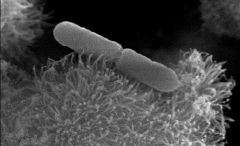Dec. 16, 2015
A bacteria's double life: living off both iron and electricity
 A. ferrooxidans
A. ferrooxidans
Researchers at the RIKEN Center for Sustainable Resource Science and the University of Tokyo have demonstrated that the bacterium Acidithiobacillus ferrooxidans can take electrons needed for growth directly from an electrode power source when iron—its already known source of energy—is absent. The study, published in Frontiers in Microbiology, shows that A. ferrooxidans can use direct uptake of electrons from an electrode to fuel the same metabolic pathway that is activated by the oxidation of diffusible iron ions.
Just as plants with chlorophyll use photosynthesis to convert energy from light into sugars needed for growth, other organisms—like animals—gain energy for the manufacture of sugars by taking electrons from substances in their surrounding environments—a process called chemosynthesis. Organisms that gain their energy this way are called chemotrophs, and those that get their electrons through oxidation of inorganic substances are called chemolithoautotrophs. Phototrophs and chemotrophs make up two interconnected ecosystems.
“We are investigating the possibility of a third type of ecosystem,” explains group leader Ryuhei Nakamura. “We call it the electro-ecosystem because microbial activity is sustained primarily by direct electrical current.”
Recently, his team has discovered geo-electric currents across the walls of black-smoker chimneys formed by hydrothermanl vents, suggesting that some deep-sea microbes might double as a electrolithoautotrophs, organisms that can use electrical potential—meaning that they simply eat electrons—as an energy source instead of light or surrounding inorganic substances.
Because access to microbes in this environment is not easy, and to verify their hypothesis that being able to switch energy sources from inorganic substances to electricity is not unique in the microbial world, the team experimented with A. ferrooxidans,a chemolithoautotrophic bacterium known to oxidize iron ions (Fe2+).
The team cultured A. ferrooxidansin an Fe2+-free environment and supplied an electrode with an electrical potential of +0.4 V, carbon-dioxide as a carbon source, and oxygen as an electron acceptor. They found that these conditions created a current that originated from the electrode, and that the strength of the current depended on how many cells were attached to the electrode. Killing the cells with UV light immediately suppressed the current.
To determine how this current was being generated, they used an artificial photochemical reaction. Normally, carbon monoxide attaches to heme proteins in A. ferrooxidans outer membranes and prevents oxidation. But, when exposed to light, this bond is broken and oxidation continues as usual. When tested, carbon-monoxide also prevented the current formed between the electrode and A. ferrooxidanscells and exposure to light reversed this block and allowed the current to flow. This suggested that a heme protein is needed for the electrosynthesis exhibited by A. ferrooxidans.
Further analysis showed that the responsible heme protein is the aa3 complex which is known to play a role in down-hill electron transfer in A. ferrooxidans that generates ATP and the proton-motive-force that allows uphill electron transfer and carbon fixation—the hallmarks of sugar production. Inhibition of a protein complex that is part of the uphill-transfer process suppressed the current, showing that the proton-motive-forces being generated were indeed used for up-hill electron transport. Additionally, the optical density of cells cultured with the electrode for eight days increased over time, indicating growth and that the current generated by electrons flowing from the electrode to the cells was being used for carbon fixation.
“Now that we have identified the metabolic pathway for electrolithoautotrophs in A. ferrooxidans,we will be able to apply this knowledge tobacteria we find in the deep sea vent,” says Nakamura. “The next step is to prove the existence of electro-ecosystems in on-site deep-sea experiments.”
Understanding electro-ecosystems and how electrical currents can support life could lead to a blueprint for sustainable human ecosystems, using technology such as fuel cells, batteries, and thermoelectric converters.”
